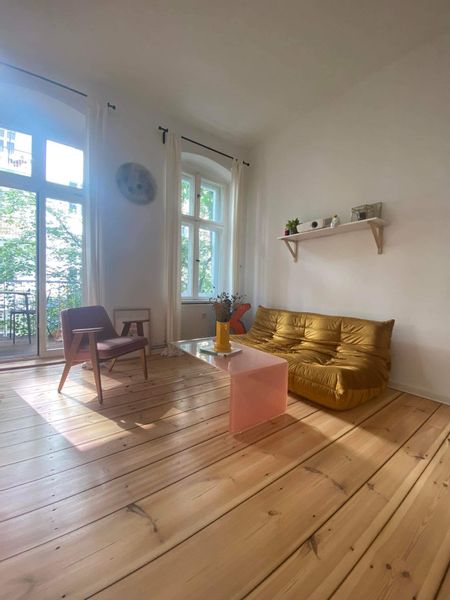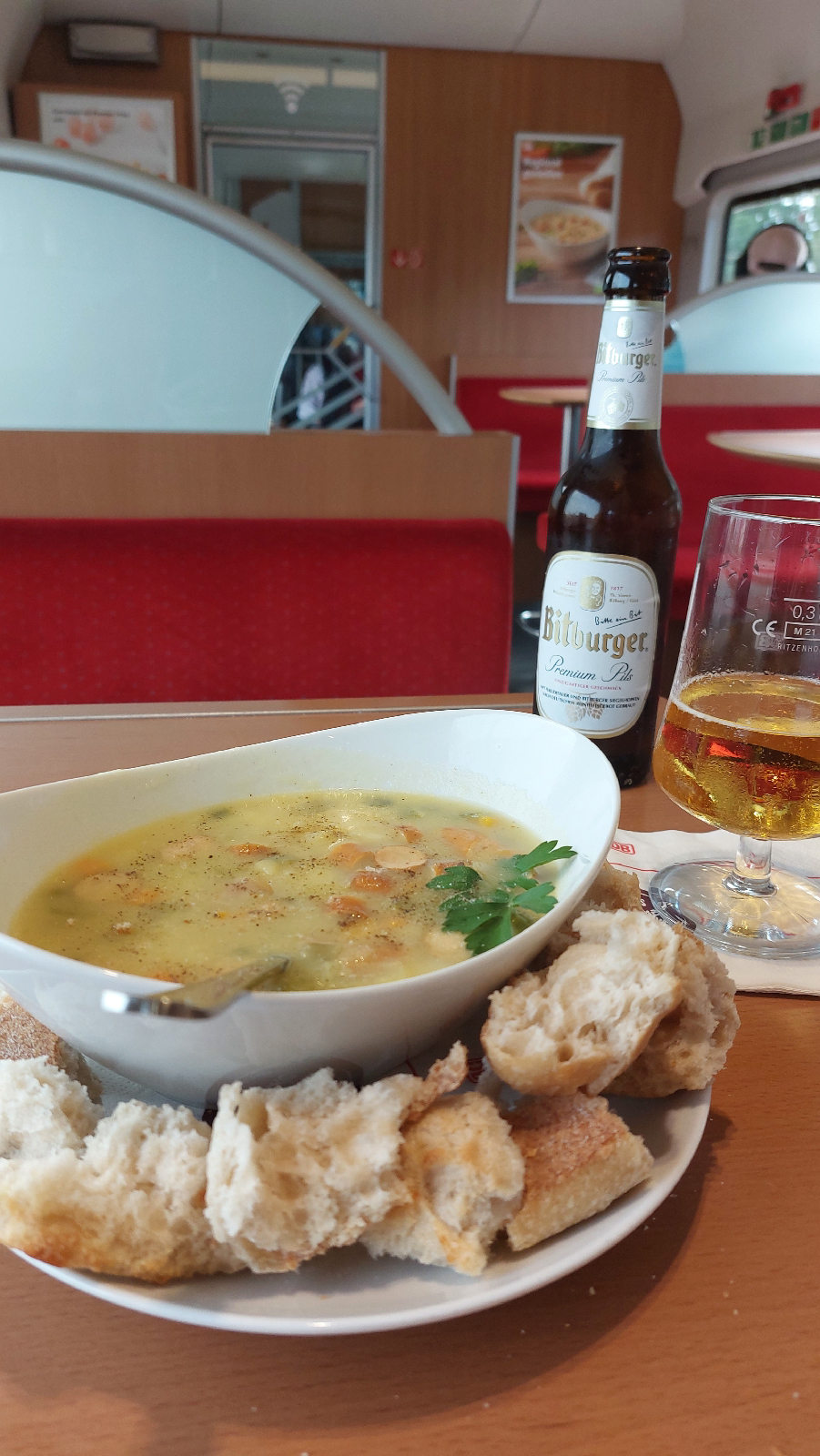
The Journey
The direct train from Amsterdam Centraal to Berlin Hbf took 6 hours and 25 minutes. Here it is arriving in Amsterdam Centraal before departure.
The journey was largely over flat agricultural land and was quite boring at times. I was surprised at how rural and forested the land was, coming from the Netherlands. I spotted some Huf houses dotted here and there. I was glad to have something to read with me to pass the time, though really fast wifi was also available for the whole trip. The train and toilet were very clean. Except for 90 minutes of the journey, I had the whole compartment to myself.
I had my two sandwiches with me from Michel and Ingrid's house, which I ate for lunch, but then I also decided to have my evening meal in the dining car before arrival.
I chose Kartoffeleintopf mit Geflügelwienern und Bio Brötchen, a hearty German stew with smoked chicken sausage, potato, carrots, onions, peas, celery and something else green! It was served with an organic bread roll. This was swallowed down with a Bitburger Pils, chosen for me by the restaurant car manager, when I couldn't make up my mind. Yum!
When I arrived it was dark in Berlin and rather than struggle with navigating a U-Bahn / S-Bahn / M4 route suggested by the BVG travel app, I checked the price of an Uber. As it was less than €7, I opted for it as the rucksack was heavy. This was a good decision!
The Accommodation
The small home exchange flat was located in Prenzlauer Berg, which was part of the former East Berlin. It is now a hip neighborhood with many cafes, restaurants and galleries.
I picked up the keys from Jeanne and Suzon's neighbour Michael as planned. On opening the door, I was greeted by two very loud and hungry cats - Léon and Simba. Here they are AFTER I fed them !!
My home for the next three days was on the first floor, with a view of a calm courtyard.
The apartment was pretty much as I expected from the HomeExchange site.

It had a nice
balcony where I was able to enjoy a morning coffee. The
decoration style was arty and minimalistic.
Exploring Berlin, Day One
It was only a few weeks before my trip that I realised that my visit to Berlin would fall during the Unification Day holidays. Everything would be closed on Tuesday, and I was told that most people were taking Monday off as well to make a long weekend of it.
So I didn't know what to expect as I headed out on my first morning. The plan was not to do any cooking or food preparation at all, however all I could see in the streets were closed doors and shuttered windows. I eventually came across a supermarket which was open, so I got enough breakfast stuff for three days. Prices appeared cheaper than at home with this lot costing just €14.
After breakfast I activated my 48 hour travel card, vhich seemed relatively good value at €20, this would cover all my travel needs until departure on Wednesday, and so I headed out looking for the tram.
The two museums I wanted to visit were the Stasi Museum and the DDR Museum to give me some understanding of life in the former East Germany. I started with the DDR Museum. This is a small private museum which is very interactive and hands-on, you are encouraged to open cupboard doors and drawers and handle some items.
The current exhibition was called GDR Daily Life in 200 Objects. What I found interesting was that a lot of it looked very familiar! Even the wallpaper looked similar to something in our home in the 1970s! The following photos are a selection from the exhibition.
I was delighted to see an East German Trabant, and even more so when you were allowed to sit behind the steering wheel. You had to wait 16 years if you wanted to buy a new one!
This one is the Trabant 601, it was 26 horsepower, had a 26 litre petrol tank, and it was in production for 26 years (relatively unchanged) from 1964 to 1990.
In the afternoon it was time for my 3-hour walking tour, booked with the GuruWalk app, called Berlin Under The Swastika. The tour explored the dramatic shift in the history of the city under the Nazis and traced the steps of the rise of the Third Reich until it came to an end. It also looked at Berlin as being the birthplace of powerful forms of resistance - big and small.
Tina our guide, a self-confessed history geek from Melbourne was an amazing font of knowledge. The most interesting part of the tour was the visit to the former Jewish quarter where Tina explained about the thriving Jewish life here before 1933, and how it was soon lost.
There are over 9,000 'stumbling stones' all over the footpaths of Berlin commemorating Jews who fell / stumbled / were killed / disappeared.
These five stones remember a family of five who perished in the house nearby, including a child.
This is a memorial to the Jewish Women's Resistance Movt.
This one commemorates 55,000 Jews who were deported from this so-called 'Jewish
Care Home' to concentration camps.
This was taken in the first Jewish cemetery in Berlin to be desecrated by the Nazis, where there was only a handful of Jewish graves were not destroyed. The stones are regarded as the equivalent of wreaths, and are a more lasting tribute to the dead than flowers.
Other parts of the tour covered the former ministry district and Reichstag, the propaganda machine, the glorification of the Fuhrer, the memorials dedicated to groups victimised by the Nazis - including the Roma and homosexuals. You would need a full blog post to cover properly everything that was shown to us, but the photos above from the Jewish section of the tour give a flavour of the full tour.
All in all, Tina covered a huge amount of information in her 3.5 hour tour, and we traversed large sections of Berlin using public transport.
Thankfully the evening was more relaxing. I had arranged to meet my cousin Malachy and his Australian girlfriend Sarah in a Biergarten near where I was staying. They have both been teaching here for the past few years, so they know the city well. It was great to get their impressions on life in Berlin and some recommendations for the next day, if museums and attractions were closed for Unification Day.
Day 2 German Unification Day
My GuruWalk walking tour started at 10am, the tour guide today was Will from England, another self-confessed history nerd whose tour was called From Marx to the Wall, the Berlin Communist & Socialist Tour.
We walked around mostly the former East Berlin seeing where historically significant events took place.
There was a lot of detail to absorb and plenty of different interesting characters from Marx and Engels ...
... on to the revolution led by Rosa Luxembourg and Liebknecht ...
Then it was on to the Cold War, which unsurprisingly took up most of the time. Here is the former East German State Council building (now the International ESMT School of Business and Management).
The lobby contains some striking East German stained glass.
Here is the new Humboldt Forum, a €2 billion reconstruction or replica of the former Palace of the German Monarchy, which was largely demolished by the East German state. It is now home to an arts and cultural centre. The craftsmanship of the building is impressive.
We could hear the Unification Day official ceremony as we passed behind the stage to get the U- Bahn to the next stage of the tour.
The new U-Bahn Humboldt station is impressive, the design by Max Dudler was inspired by a stage design for the opera The Magic Flute and features a starry sky on a dark blue barrel vault with points of light over the tracks.
We viewed some impressive apartment buildings on the main street of East Berlin.
East Germany decided to build these 'Palaces for the People' to celebrate Stalin's 70th birthday. The street was called Stalin Allee and it later became Karl Marx street. This intersection is an important landmark as the People's Revolution of 1953 started from here.
We then went on to see a memorial plaque to commemorate one of the many small and large concentration camps that were set up all over Berlin. This one was termed 'The Murder Cellar'.
In the recent past, the building was occupied by clothing brand Thor, till anti-fascist protests in 2009 forced them out and their clothing stock was burned.
The tour ended up at the East Side Gallery, an aptly-named section of the Berlin Wall which has become an open air gallery of images, mostly celebrating the rise in leftwing movements in recent years.
It was a thoroughly informative and interesting tour. Will was an excellent guide, providing an enjoyable and engaging presentation of a complex topic. He pointed out details which I would never have seen or even notice without his guidance.
When the tour finished, he recommended that we should stroll down to the Kreuzberg area as far as the canal. Here I bought a range of German street food from a row of food trucks and had a picnic by the water, before heading back to East Side Gallery to pick up an open-top bus tour, as I knew that it would be impossible to see the whole city without one.
The bus tour did cover some of the same ground that I had already covered, I didn't really mind as it felt so good to be just sitting back and listening after 4.5 hours of walking! I will only include one or two of the many photos here that I took from the open top tour ....
The Cube building is an intelligent building, it has 8000 AI sensors that learn from the workers who work there.
This beautiful building is the residence of the German President.
Finally, the infamous Checkpoint Charlie was crowded with tourists, but worth seeing nonetheless.
My overall iimpression is of a city still changing and still dealing with reunification more than two decades on, where the differences between East and West Berlin are still visible if you look, though not always obvious at first sight.
I also had no idea thst the city was so spread out; both tour guides mentioned that it had an area nine times the size of Paris, and a population of 3.5 million. I hadn't a hope of seeing everything I wanted to in two days, but I feel that I now know it at least on a surface level. There is definitely enough to see and do here to merit a return trip - and a longer one at that, a time when hopefully the Stasi Museum will not be closed!









































Comments
Post a Comment